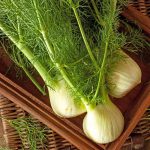 An herb grown for its aromatic foliage and seeds.
An herb grown for its aromatic foliage and seeds.
From the first century A.D. to the fifth century, the people whose descendants founded the British Empire did not yet live in England (England was not even named England yet). These people, now called the Anglo-Saxons, lived on the northern coast of Europe and spoke a language that sounded more like German than what we now recognize as English. Thanks to occasional encounters with travelling Roman salesmen, they also had exposure to Roman spices and Latin words, including/em’cw/Mm, the name of a plant whose leaves taste like anise. This name entered Old English asfinul, and by the fourteenth century it had acquired its present spelling, fennel. Much later, in the early eighteenth century, the Italian name of this plant—finochio, which also derived from the Latin feniculum—was adopted as the name of a particularly sweet kind of fennel. Amazingly both fennel and finochio are related to the word female: they all derive ultimately from an Indo-European source that meant both to nurse and to produce. This Indo-European source developed on the one hand into femina, meaning she who nurses, which later evolved into female; it developed on the other hand into fenum, meaning hay (the “produce” of a marsh), which later gave rise to feniculum, literally meaning little hay.
Aromatic herb of the carrot family which contains rutin and vitamins and minerals including calcium and potassium.
A perennial herb (Foeniculum vulgare) grown for its foliage, seeds, and anise-like flavor. It is also widely used as a digestive aid, e.g., in infantile colic, and used as a potential source of estrogen-like compounds. Known side effects of exposure to fennel in some agricultural workers include asthma, rhinitis, and conjunctivitis.
This delightful herb is adorned with lustrous, emerald-green, and feathery leaves, as well as striking yellow flowers. Its flavor is moderately evocative of licorice, and both the stems and leaves are employed in a variety of culinary applications, including sauces, soups, salads, and garnishes. When whitened, the stems can be eaten raw, or alternatively cooked, akin to celery or Belgian endive.
Fennel, the appellation given to various fragrant plants indigenous to Europe but now also grown in North America, is a remarkable herb. One of its species is a robust perennial, standing at 4 to 5 feet tall, having hollow, dark-green stems and intricately divided leaves of a luscious green color. The blossom stems come to view shortly after mid-summer, sporting heads of vivid yellow flowers, yet as the production of seeds shortens the lifespan of the plants, gardeners usually eliminate the stems to prevent flowering. The stems, leaves, and seeds provide a subtle licorice taste. The feather-like foliage, comparable to parsley, is employed to embellish dishes and enhance the flavor of sauces to go along with salmon and mackerel. Fennel seeds are also useful for seasoning and the creation of liqueurs.
